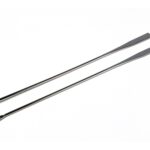Quick reference — Three Strengths
All mixes are measured in drops (use a glass palette + dropper or your paint stirrer). OMS = odourless mineral spirits.
Light — ambient dust/grime
- Industrial Earth: 2 drops
- Buff: 1 drop
- Starship Filth: 0 drops (skip or 1 tiny touch if you want faint soot)
- OMS: 24 drops
→ Paint : OMS ≈ 3 : 24 (≈ 1:8) — very thin wash
Medium — default surface grime (recommended starting point)
- Industrial Earth: 3 drops
- Cassel Earth (or Bitume): 1 drop
- Starship Filth: 1 drop
- OMS: 25 drops
→ Paint : OMS = 5 : 25 (1:5) — good balance for panel edges, lower surfaces
Heavy — saturated grime / road film / lower hull
- Industrial Earth: 4 drops
- Bitume: 1 drop
- Starship Filth (or Smoke): 1 drop
- OMS: 18 drops
→ Paint : OMS = 6 : 18 (1:3) — strong, stays in recesses, use sparingly
Optional: add 10–15% acetone of the OMS volume to any mix to increase capillary action and speed drying (e.g., for the Medium mix above, replace 2.5–3.75 of the 25 OMS drops with acetone). Use acetone sparingly — it dries faster and can push the wash further into seams.


Bench-test (one-minute, immediate observations)
- On a scrap painted Dunkelgelb patch, spray a thin gloss/semi-gloss clear (or use an already gloss section).
- Mix Medium formula (5 paint drops + 25 OMS drops) on a glass palette, stir 10–15 seconds.
- Apply with a soft round brush into a panel line and across a flat area.
- Observe: within 10–60 seconds the wash should flow into recesses and soften the panel edges. If it beads up, your gloss isn’t slick enough or mix is too fatty — add 5–10 OMS drops.
- Blot excess with a clean cotton bud lightly dampened with OMS to see removal behaviour. If the wash lifts completely, reduce OMS (make slightly thicker) next test.
- Note drying: tack up in minutes; touch-dry in hours; fully cured 24–48 hours depending on humidity/acetone.
Step-by-step application
- Prep surface: seal your Dunkelgelb base with a thin gloss or semi-gloss clear coat (this helps the wash flow without staining the paint).
- Mix on glass palette: add paint drops in order (darker last), then OMS. Stir thoroughly with a metal paddle or toothpick until homogeneous.
- Test on scrap (see bench test). Adjust ratio if needed.
- Apply: load a soft round brush, touch into recesses/panel lines, then pull across lower areas and around fastener heads. For realistic grime, concentrate on: lower hull, wheel wells, panel joins, rivet heads, and places where rain would streak.
- Work quickly for streaks: after applying, drag the brush downward in short vertical strokes to create rain streaks.
- Remove excess: before it films over, use a clean brush or cotton bud slightly moistened with OMS to lift and soften the wash where you don’t want heavy accumulation. For sharper recess shading leave it alone.
- Build layers: multiple thin passes beat one thick pass — let each pass tack up before adding another.
- Seal with a thin matte varnish after fully cured to lock it in.
Variants & uses
- Oily/engine grime: increase Starship Filth + a touch of Smoke; reduce Buff. Use Heavy ratio.
- Dusty/dry weathering: increase Buff (1–2 drops) and use Light ratio; apply broadly and then a few streak passes.
- Rail/track splatter: add a touch more Bitume and flick with an old toothbrush for speckle; keep medium-to-heavy for accumulation under bogies.
Tips & troubleshooting
- If the wash won’t flow → add more OMS in small increments (5 drops).
- If the wash lifts the base paint → ensure base has a proper gloss sealer, or reduce acetone percentage and let surface cure longer.
- If the wash dries tacky/slow → add a touch more acetone (careful) or increase ventilation.
- For controlled capillary action, use thinner (more OMS) and a slightly glossier sealer. For sharp snap-into-recesses, use a glossier surface and slightly thicker wash.
- Keep a scrap card with Dunkelgelb handy for quick tests. Record favourite ratios.

James (Doc) Wooldridge
James is a dedicated scale modeller, researcher, and respected author with a deep passion for the craft. His meticulous approach brings exceptional detail and historical accuracy to every project. Renowned for his super-detailing techniques and authentic colour schemes, James has been featured on Scalemates and even in Google Featured Snippets. As an active contributor to a leading scale modelling Facebook community, he regularly shares innovative techniques and fresh perspectives. He also produces engaging video tutorials for a major scale modelling club and is an accomplished scale model photographer, presenting his work with professional polish. A founding executive of both KSM–IPMS and Kawartha Scale Modellers, James continues to shape and inspire the hobby through visionary leadership, creativity, and an unwavering commitment to excellence.💡📏 📐📱🎬 📷 🎥



